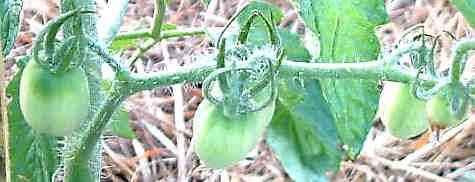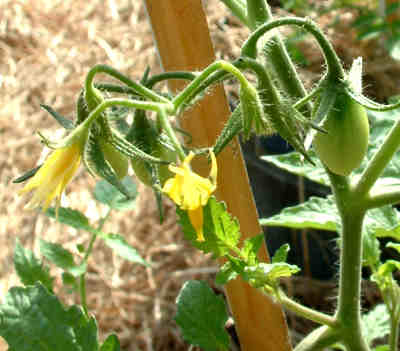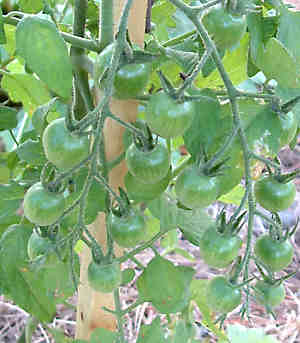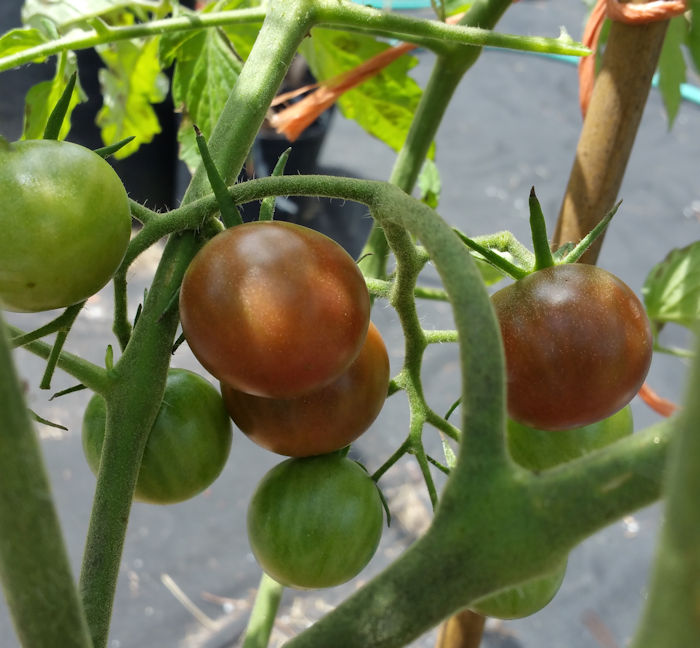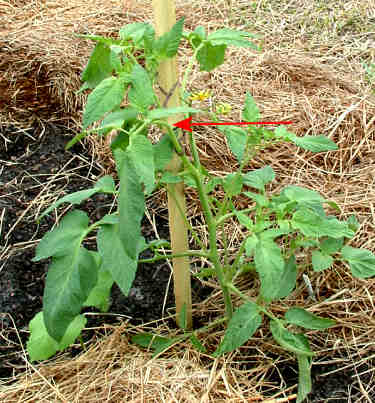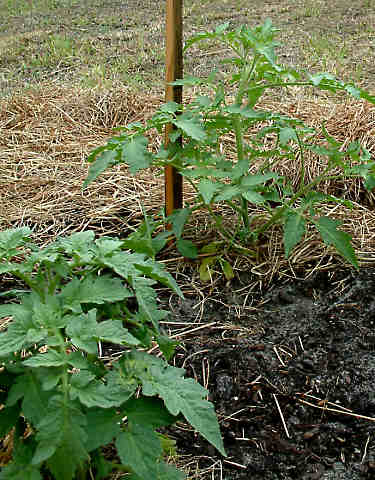Hybrid Tomatoes and the Garden
Hybrid tomatoes are deliberate crosses between two different tomato varieties. Hybrid tomato plants are often thought of as being more productive or disease resistant – but not as great tasting as heirloom tomatoes. Is that true? And how are these hybrid tomato plants doing in my garden?
Hybrid Tomato Varieties
Although I mostly grow heirloom or open-pollinated tomato varieties, I do grow some hybrids. I especially like some of the cherry tomatoes. Then of course I have to try something new every year — you never know when something will earn a continued spot in the garden.
This year, I am growing the following hybrid tomato plants:
- Celebrity Bush (determinate slicer)
- Fabulous (determinate slicer)
- Goliath Bush (determinate slicer)
- Juliet (cherry)
- Park’s Whopper (indeterminate slicer)
- Supersweet 100 (cherry)
- Tomatoberry (strawberry-shaped cherry)
So how have they been faring?
The Cherry Tomatoes Win for Productivity
That’s really no news, since cherry tomatoes are known for their prolific yields. But one variety in particular is amazing — Tomatoberry.
I bought Tomatoberry because the description sounded intriguing — a cherry tomato the size and shape of a strawberry. While I’m not sure that the fruits are really strawberry-shaped (although I do see a slight resemblance on some of the fruits), the plant is amazing!
I didn’t take a photo of the awesome flower sprays this plant has, and so far, pretty much each flower has set a fruit. So “prolific” is a little bit of an understatement. I’ll have to take a photo as the tomatoes start to turn red — that will be a sight! (I wish I had taken a better picture to show what the spays of tomatoes are like.)
Juliet bears some lovely fruit — it’s a grape cherry tomato. While setting on nearly every blossom, it’s not quite in Tomatoberry’s league. Then again, I am growing Juliet in 5-gallon containers! I imagine that Juliet would do far better in a larger container, or in the ground.
Supersweet 100 was the first of the cherry tomatoes to set fruit. Once again, pretty much every flower sets fruit. I have it growing in the ground, but it’s not in the best location — it only gets about 6 hours of sun a day.
It’s been nibbled by a bunny, blown down in a windstorm and I’ve not always been the best in watering that particular area. Still, this plant continues to grow and set fruit with abandon. I’d call it quite hardy in less-than-desireable conditions. I’ll have to grow one of these plants in the main garden that gets full sun one of these days. That should be a sight!
Well, this post is getting kind of long, so I’ll stop for now, and pick up later with the report on the slicer-sized hybrid tomato plants.
Can I Grow Cherry Tomatoes in a Container
If you’re asking, “Can I grow cherry tomatoes in a container – successfully?” then the answer is yes – with a few small qualifications. Here’s what you need to know about growing your cherry tomato plant in a pot/container.
Growing Cherry Tomato Plants – Soil
First off, growing cherry tomato plants really isn’t any different from growing any other kind of tomato plant. They all need direct sunlight (at least 6 hours a day), water and fertilizer (preferably organic). A good soil to use in the container is a combination of compost and organic potting mix. (I like half and half myself).
I’ve tried growing tomato plants in just compost and in just organic potting soil, but I find that the two mixed together have produced the best growth. Mix in some extra perlite or vermiculite for drainage.
Another option is to use compost mixed in with some sphagnum moss and perlite.
Don’t use soil from your yard in the container; it may compact easily in a container, and it’s quite possible there are unfriendly bacteria in it.
Container Size
What size of a container should you use for your cherry tomatoes? Part of the answer depends on the variety of cherry tomato you plan to grow – determinate or indeterminate. (Learn more about the difference between determinate or indeterminate on the tomato growing terms page.)
In general, determinate varieties are shorter and smaller than indeterminates. Unless you are growing something like Micro-Tom (smallest tomato there is), the minimum size for a container should hold 3 gallons of potting mix/compost. However, if you can manage a 5-gallon container, your tomato plants will thank you by providing more fruit.
Now for the indeterminate cherry tomato plants. While I certainly have grown indeterminate cherry tomatoes in a 5-gallon container, they grow much better in a 10-gallon. (I even have a few 20-gallon pots for the cherry tomato plants that get very large like Blondkopfchen.) So, a 5 gallon container is the minimum, and a 10 gallon will have your plants thanking you. While I haven’t grown SuperSweet 100 in a container (yet!) I think it would work quite well.
Fertilizer for Cherry Tomatoes
The general rule of thumb for container growing is apply half as much fertilizer, twice as often. I like to use liquid fertilizer that I dilute to half-strength, then apply it twice a month.
You need to fertilize more often in containers for two reasons. First, what fertilizer you do use gets washed out from the extra waterings that container plants need. Second, your cherry tomato plant’s roots only have so much room to grow, and sooner or later, they will run out of space. Since they can’t expand further, they need to extract everything they can from a limited area.
Which fertilizer to use? I primarily use organic methods (compost, fish emulsion, kelp meal, Terracycle and Tomatoes Alive!), there are times of extremely rapid growth where I admit to using Miracle-Gro for Tomatoes. While my in-the-ground-garden tomatoes get organic, I find that the container-grown plants do need a little boost at times. Of course, that could be because I am in a hot climate. You’ll have to experiment for yourself.
(You can also check out the posts I made about organic versus chemical fertilizers, as well as fertilizer components.)
Watering Your Cherry Tomato Plants
You really do want to put your containers where you have easy access to water. Especially as they grow larger and the weather gets warmer, you will find that you’ll have to water often. During warm and windy times, I have to water my containers daily — and there have been very dry times where I’ve needed to do it twice a day!
Try to keep the soil moist but not wet. The more of an even moisture level of the soil, the less the chance your tomatoes will crack badly should a heavy rain arise.
A mulch will help to keep moisture in the soil longer. I like to use an inch or two of hay, but I realize not everyone has easy access to it. Other mulches can be bark chips, dried grass clippings, chopped leaves and even shredded paper! (Just make sure the paper doesn’t have colored ink on it.) In addition, some people also swear by red plastic for a mulch.
Can I Grow Cherry Tomatoes in a Container?
By now you see the answer is yes, you can successfully grow and harvest cherry tomatoes in a container. With just a little preparation and attention, you’ll find yourself with tasty snacks that are good for you!
Heirlooms in the Garden
The heirlooms in the garden are growing strong! With 2 days of gentle rain, the plants are rocketing skyward. Who said hybrids were the only ones to grow fast?
I mentioned in my post for the last heirloom tomato report that I’d post some photos. I just walked out to the garden, camera in hand, so here they are!
How Fast Have They Grown?
On this past Sunday (March 15th), I decided that I’d go around with my Sharpie permanent marker and mark how high the plants were. That way, by Sunday the 22nd, I could tell how fast they had grown.
I decided to wander out with my camera today and Brandywine has declared its intentions to make a run to the top of the 6-foor pole. See the red arrow? That’s pointing to where I marked its height on Sunday. And blossoms? The photo doesn’t show it, but there are lots and lots on the plant.
But Kellogg’s Breakfast isn’t far behind! Nor are my Pinapple tomatoes, for The Great Tomato Experiment.
Truth be told, every tomato plant is showing marked growth since Sunday. The plants that have gained the least height are my Loxahatchee plants. On the other hand, they have apparently decided that large, dark green leaves and flower buds are more important, and they are truly lovely plants.
Here’s a photo showing Loxahatchee (foreground) and Kellogg’s Breakfast (background). And speaking of Kellogg’s Breakfast, it’s also gotten a lot wider, as well as a fair amount taller.
(By the way, you can click on the photos to see a larger image.)
Black Sea Man and Druzba have grown, but not quite as spectacularly. Then again, they are both much younger plants, being in the main garden for not even 2 weeks yet. Actually, I kind of take that back — Black Sea Man has grown some huge, long leaves, and gotten quite wide. It’s just only grown an inch taller in height (which isn’t as exciting as Brandywine growing 5 inches).
The others are also doing well; White Bush is blossoming, and I can’t wait to see the ripe tomatoes on it (getting ahead of myself, though). Eva Purple Ball and Pruden’s Purple are about a week away from being transplanted into their final spots.
Oh, you may be wondering who won the blossom contest (i.e. which heirloom had the first open blossoms). The winner was…Pineapple, closely followed by White Bush. Brandywine followed and all the older plants (those that have been in the ground for at least 3 weeks) all have buds.
So that’s it for today. And if you’re womdering if I grow any hybrids, the answer is yes…and those photos are reports are coming up shortly!
Heirloom Tomato Report
I thought I’d update you with an heirloom tomato report, on how these wonderful plants are growing in the garden. I’ve had extremely unsettled weather from January through the beginning of March and the tomatoes have taken it with differing results. Here’s a homegrown heirloom tomato report!
Heirloom Tomatoes in the Garden
First, in case you aren’t aware, I am in South Florida. Although my winters have been pretty mild in the recent past, it was a cold one this year, with several freezes. Last week’s temperature dip into the 30’s didn’t help matters. But it’s warming up now, and the plants look happier.
Here’s a list of the heirloom tomatoes currently in the garden:
- Black Sea Man: Determinate, black fruit
- Brandywine: Indeterminate, pink fruit
- Druzba: Indeterminate, red fruit
- Eva Purple Ball: Indeterminate, dark pink fruit
- Kelloggs Breakfast: Indeterminate, orange fruit
- Loxahatchee: Semi-determinate, red fruit
- Mr. Stripey: Indeterminate, bicolor yellow/red fruit
- Pineapple: Indeterminate, bicolor yellow/red fruit
- Pruden’s Purple: Indeterminate, dark pink fruit
- White Bush: Determinate, white fruit
And here are the heirloom plants that (sadly) succumbed to one of the freezes:
- Big Rainbow: Indeterminate, bicolor yellow/red fruit
- Green Zebra: Indeterminate, green striped fruit
- Yellow Cherry: Indeterminate, yellow fruit
That’s not too bad, though — just three that are more temperature-sensitive.
Last Week’s Cold Snap
Almost all the plants got nipped by the dip into the 30’s last week. Green Zebra was the only casualty, but all the other plants except two showed signs of stress and/or what I call “freezer burn” on some leaves.
The two heirloom tomato varieties that came through totally unscathed were Loxahatchee and White Bush. Both acted as if the cold snap never happened. Unfortunately, White Bush doesn’t seem to be in circulation anymore (couldn’t find any seeds for sale) and Loxahatchee is from my own heirloom breeding program, and I don’t have enough seeds to offer for sale at the moment.
Heirloom Tomatoes — Who’s Blooming?
Mr. Stripey is the only one with tomatoes and blossoms, but that’s the one variety I bought as a plant; all the rest I have grown from seed.
None if the seed-grown plants are actually in full blossom at the moment, but about half have small (and in Brandywine’s case, not so small) blossom buds. So far, I expect Brandywine to have the first open blossoms, probably by Saturday.
The heirloom tomato plants that aren’t showing blossom buds, like Druzba and Pruden’s Purple, are just too young yet (I just put them in the garden a few days ago). I plant my tomatoes is waves, hoping to extend the season. While it doesn’t always work (sometimes they all stubbornly decide to ripen at the same time no matter what I do), sometimes I get lucky.
I’ll be taking some photos this weekend of the various heirloom tomato plants. I’ll also be updating The Great Tomato Experiment report. Meanwhile, you can take a look at other posts I’ve written on heirloom tomatoes.
When Bunnies Invade
It’s a sad day when you go to the garden to admire your newly planted tomatoes and see the tops gnawed off. The bunnies are back, and they have invaded the garden.
No, I hadn’t put up fences this year; the rabbits had apparently taken a hiatus, and I haven’t seen any around for the past year or so. I guess they were just taking a vacation, because I seriously doubt it was squirrels getting the urge for greenery (the only other wildlife around).
Defending Against Garden Invaders
Be it bunnies or deer or some other form of greens-eating animal (goats anyone?), how can you keep them out of your garden? I can only speak to rabbits and goats, as there aren’t any deer in my neck of the woods.
In the past, I have used 4-foot tall fences to completely enclose the garden area. Although bunnies could burrow under the fence, they didn’t seem to want to take the trouble to do so. For more persistent wildlife, you may need to bury the bottom of the fence 6 inches down.
Another thought is a spray you can make (or buy) with hot peppers as an ingredient. One munch of a hot-pepper-sprayed leaf and I doubt the bunnies will come back anytime soon. Seems like it would probably work for goats and deer as well. However, it’s a relatively short-term solution; you’ll have to keep on spraying.
I also have heard that bunnies don’t like the scent of bloodmeal — easy to find and relatively inexpensive. The problem is that if you get rain, you’ll need to re-apply. (Then again, it’s a fertilizer for the plants.)
As far as deer and their relatives (elk, moose, etc.) go, I understand that a tall fence is needed to keep them from bounding over into the garden area. I’ve also seen something called Plantskydd Deer Repellent that might prove interesting. It’s rain-resistant so you won’t have to keep spraying so often.
The Poor, Poor Tomatoes
Regarding the two tomato plants that have been gnawed upon, I don’t know if they will survive. Maybe, but if they do, the plants will be rather interesting-looking. I’ll give them a week or so before I decide what to do. If they start growing again, I’ll keep them where they are.
Meanwhile, today I must find my short cages and put them up around the tomato plants. They aren’t tomato cages per se, but they should work fine to frustrate the bunnies (the holes between the wires are pretty narrow — not enough to let the bunny teeth near). The rabbits don’t seem to care for the larger tomato plants, so for the time being, just the newly-transplanted seedlings will get the cages.
Hopefully the garden invasion will stop!
Update
The bunnies didn’t do any permanent damage to either the SuperSweet 100 or White Bush tomato plants (the two worst munched). Several weeks later, SuperSweet 100 is urn-shaped (2 main shoots) but is starting to put forth some tiny blossom buds. White Bush, who I was most worried about, took it all in stride and looks healthy and happy as can be. And yes, it has tiny blossom buds as well. ![]()
In this case, all is well — whew!
